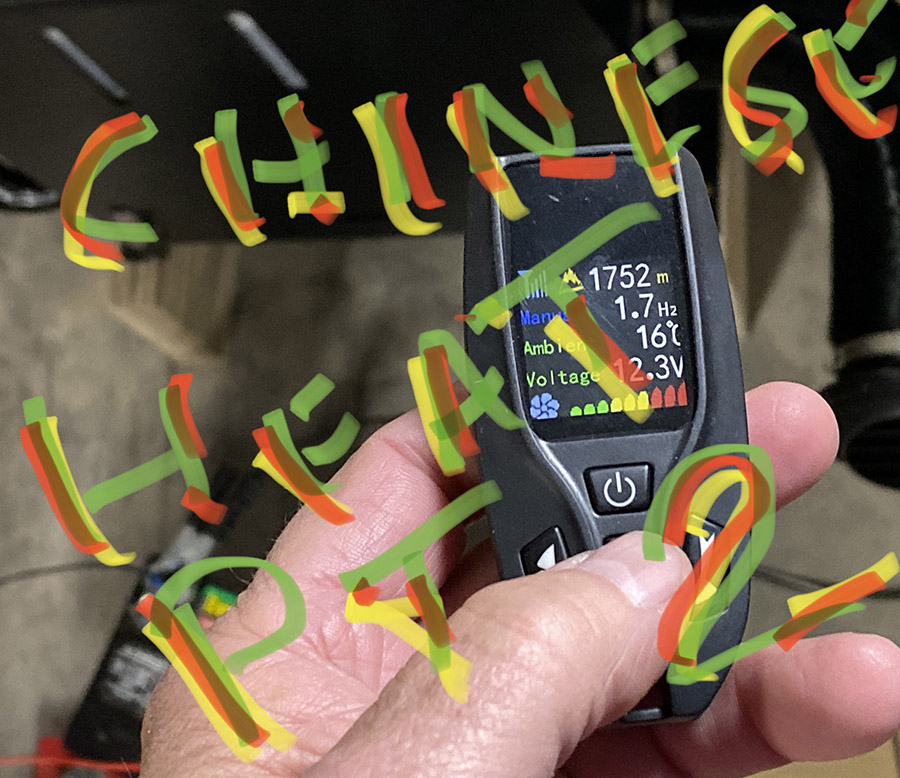By Joe Gresh
There are a couple styles of these Chinese heaters. I bought the all-in-one, suitcase version. My Chinese heater came mostly assembled and all I had to do was rig up the included exhaust pipe, air intake, output duct, and connect a 12-volt battery. If you’re going to install the heater in a van I think the version broken into separate parts would be a better choice. In fact, maybe it’s the better choice regardless.
My suitcase Chinese heater works okay but you can smell diesel fuel even when it’s not operating because the fuel tank cap is vented. It’s not a strong smell and my shed is pretty drafty. If my shed was sealed tighter the fumes would be more noticeable. The heat output has no diesel smell but it has some sort of odor I can’t quite place, maybe it’s the plastic housing covering the heater cooking off or it could be the smell of air on hot aluminum. Anyway, it’s not an objectionable smell and I remain fully conscious when the heater is running.

Installation was a breeze and only took about 30 minutes. I mounted the unit on two recycled pieces of 2×6 form wood to get the exhaust pipe high enough to go over the shed sill and punched a 1-inch hole in the shed wall for the combustion gas exhaust.
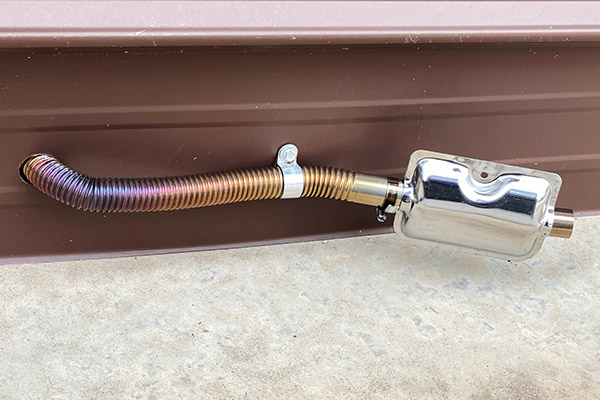
For the combustion air intake I simply strapped the air filter to the side of the heater with a tie wrap. I was kind of excited to see if the Chinese heater would actually heat so I hung the output pipe in mid-air and connected a 12-volt lawn mower battery for power.
My unit came with the cheapest controller available and maybe that’s because I bought the cheapest available heater. I can’t say. The poorly written installation manual gave a “5-push on the unit’s start-stop button while holding the remote control button down” type of pairing instruction. After a few tries I was surprised that the remote control linked up with the heater and could turn the machine on and off. In Chinese Heater: Part 1 I mused about replacing the control with a fancier unit but after seeing the el cheapo in action I’ll just stay with it until it breaks.
These Chinese heaters follow an automated start up process. First the blower comes on at slow speed, then the glow plug (or igniter) starts heating a small metal screen in the combustion chamber. Next, the fuel pump starts pulsing to supply fuel to the combustion chamber. A few minutes after pushing the on button you’ll hear the fuel ignite with a muffled roar and the blower will pick up speed. In the final step the glow plug turns off and the unit burns the diesel fuel from the red hot metal screen. If anything goes wrong with the startup the heater will try again. You really get an amazing amount of technology for 120 bucks.
Of the ten times I’ve started it my machine failed to launch once, but on the next try it was ok. The heater puts out a fairly good stream of heat and in a smaller space it would work well. Unfortunately, my large, steel shed has zero insulation and gaping holes everywhere so the unit had to be run flat out to effect any change in the shed temperature.
It took about 30 minutes to raise the shed temp from 42 degrees to 48 degrees and that was about as warm as it got. That’s still better than no heat at all. I think if I had three more Chinese heaters I could get it nice and warm inside.
Shutting down the Chinese heater takes about 5 minutes as the blower keeps running until the combustion chamber cools down. Shutdown is also fully automated and all you have to do is press the power button until the remote displays off and then wait. It’s probably not a good idea to cut 12-volt power to the unit during shutdown, as the plastic heater housing would probably not like that.
One of the reasons I recommend the break-down version is that you are free to mount the fuel tank outside. In fact, you could mount the entire unit outside and poke two holes for a return air and hot air registers. Mount the control panel on the wall and you don’t even have to go outside to turn the little beast on. Outside installation would eliminate any diesel odors, as you would have only warm air pumping into your shed. The entire combustion cycle would be on the other side of the wall, free to stink up the planet.
Noise is another concern that favors outside installation. My Chinese heater made a bit of noise. You hear the burning process, it sounds like a furnace kicking in but quieter and the blower makes normal blower noises depending on what power level the machine is operating. The fuel pump has a slight ticking noise that isn’t noticeable at high power/high blower speed. As you turn down the heat output the blower gets much quieter and the pump ticking becomes more noticeable. None of this matters in my situation because it’s a shed and I run the heater at full power all the time. The heater isn’t so loud that you can’t carry on a conversation standing next to it.
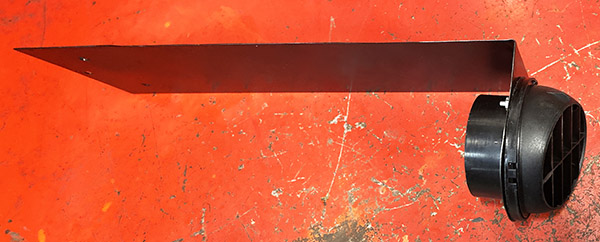
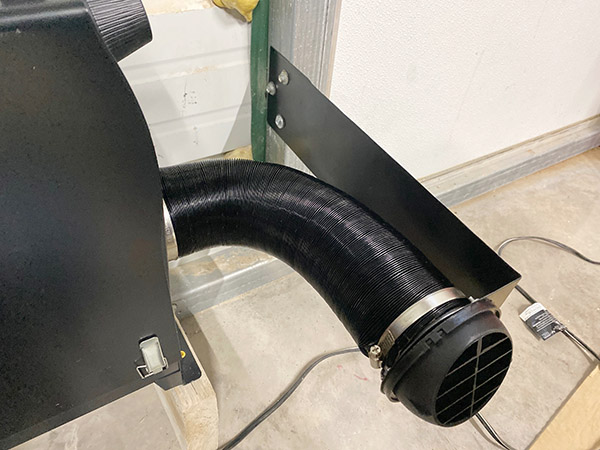
Once I was sure I was going to keep the little heater I bent a piece of sheet metal to hold the ductwork. Without a brace the hose kind of wiggled around, describing a figure eight in space.

As a test, I marked the fuel level of the see through tank and added 1 quart of diesel fuel. The heater ran over two hours at full power on that quart. Of course if you turned it down like you would in a van or RV it would burn even less fuel. 1.7hz was the lowest power setting, meaning the fuel pump cycled 1.7 times per second. 5.5hz was the highest setting. I’m not sure it works like this but if 5.5hz burns a quart every two hours then a setting somewhere south of 3hz should double your fuel mileage and halve your heat output.
Since the shed is off-grid and runs on solar power I have tons of 12-volt DC power available. There are 12 deep cycle batteries on a rack outside the building and a 12-volt breaker panel but I don’t have any conduit to where the heater is located. These heater units use a good bit of DC power when first starting, maybe 8 amps or so. Once the glow plug shuts off the unit runs on the red-hot screen that surrounds the glow plug, kind of like an old Cox .049 model airplane engine. With only the blower running my 2-amp trickle charger kept up with the demand. If you are using the heater in a van make sure you don’t drain your battery running the heater.
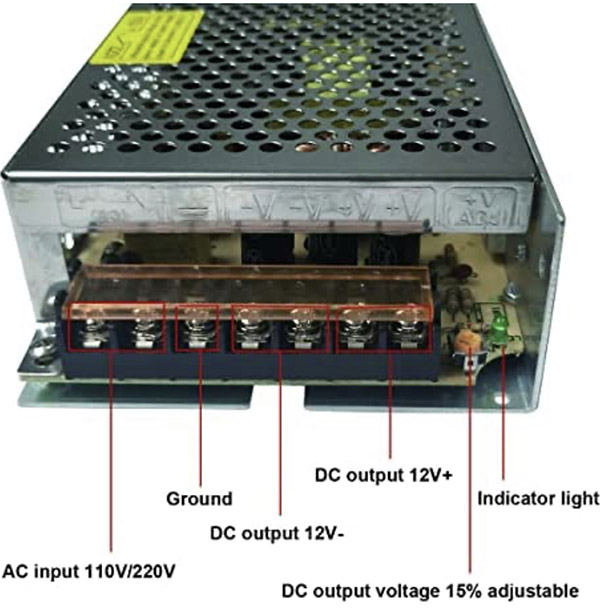
I’ve ordered a temporary, 15-amp, 12-volt power supply to run the heater off 120VAC. Eventually I will get around to connecting the heater to my battery bank. There is a drop of around 1-volt between what the remote display says is available at the heater and the actual battery voltage measured at the battery terminals. I might run some heavier wires to the heater control board. Most likely I won’t worry about the voltage drop because I just like saying voltage drop.
From my online research the only parts that go wrong with these Chinese heaters are glow plug failures and blower motor bearings. These problems don’t seem to crop up until a few years have passed. Parts are available and cheap for the heater so it should last a good long time with regular service. After a few years of running dirty fuel oil the combustion chamber may soot up requiring a clean out. Again, the gasket kits needed for this procedure are easy to find online. There’s a vibrant Chinese heater community on the Internet. It’s like owning a CSC RX3 adventure motorcycle.
The heater works and it produces heat, which is all it promised to do. My unit is rated at 8kw, which works out to 27,000 BTUs. I’ll still need to wear a jacket in the winter. Future modifications may be to relocate the combustion air intake to the outside so I don’t suck my hard-earned, heated shed-air into the combustion chamber and out the exhaust. Maybe I’ll move the whole magilla outside. A carbon monoxide alarm in the shed wouldn’t hurt either. I think if your shed is maybe 20 X 20 feet and well insulated the Chinese heater would work well. If you are into the Van Life thing a Chinese heater could be just the ticket to stay warm without running the van engine.
In the future I’m going to try recycling my used motor oil at 25% used oil to 75% diesel. I have a lot of old motor oil and I might as well use it to heat instead of pouring it into the Autolube tank on my Yamaha like my buddy Hunter does. If you decide to get one of these heaters let us know how it works for you.
Help us bring more stories to you…please click on the popup ads!
Part 1 of the Chinese heater saga!
Never miss an ExNotes blog:












